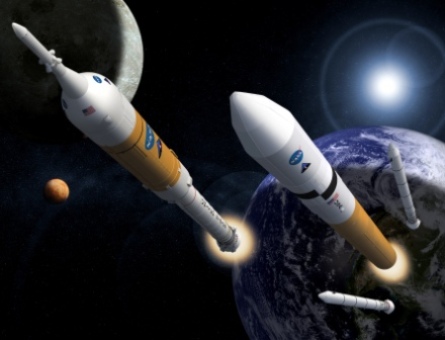As NASA publicised its Ares I crew launch vehicle's preliminary design review (PDR) completion on 10 September, issues concerning other Constellation programme vehicles emerged at the American Institute of Aeronautics and Astronautics' (AIAA) Space 2008 conference held in San Diego that same week.
Those issues include the Orion crew exploration vehicle's (CEV) heat shield selection, an Altair Lunar Lander that is unable to land everywhere on the Moon and a CEV launch abort system (LAS) that could be too heavy.
At the conference, Constellaton's transportation architecture chief Brian Muirhead told Flight the CEV's PDR would be delayed by up to 10 months to next year's third quarter. One of the technical challenges related to this is Orion's heat shield.
 |
|---|
© NASA |
Instead of this November, Orion's previous PDR date, either Phenolic Impregnated Carbon Ablator (PICA) or a version of the Apollo programme's Avcoat will be chosen for the shield early next year. Tests have suggested that Avcoat would be lighter than PICA.
"There has been talk of flying stuff on Shuttle, with tiles made of Orion [candidate TPS materials]," says Lockheed Martin thermal protection system engineering development unit lead designer Brian Hinde, speaking at the conference.
Other changes to Orion include a phased array antenna, not high-gain, no launch abort landings in the north Atlantic due to its high sea-states and a parachute configuration that is similar to that of the Space Shuttle solid rocket booster.
Orion's LAS also has mass problems. It is at 7,045kg (15,500lb) but its mass allocation was about 6,360kg. The final figure will be unknown until the CEV crew module mass is fixed, which is being delayed by its landing system's air bag design. To save weight, a LAS thrust optimisation system is being investigated to reduce the propellant mass by 113kg. Paresh Parikh, NASA Langley Research Center-based deputy integration management manager for the LAS office, told Flight: "The whole [Orion-Ares] system doesn't close on mass and power yet."
Altair is still at a pre-point of departure vehicle design with a 45,000kg mass boundary due to NASA's Ares V cargo launch vehicle's payload limit. Conducting a study with industry to review its "minimal functional" design NASA has concluded that Altair could only reach 80% of the Moon, when it was intended to have "global capability". With no final decision on what the ascent and descent engines' propellant will be, both options have technical challenges, including the need to stop hypergolics from freezing and cryogenics from evaporating.
Source: Flight International


























